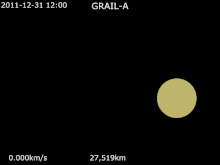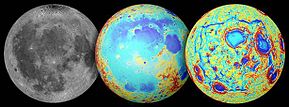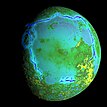 Artist's interpretation of the GRAIL tandem spacecraft above the lunar surface. Artist's interpretation of the GRAIL tandem spacecraft above the lunar surface. | |
| Names | GRAIL |
|---|---|
| Mission type | Lunar orbiters |
| Operator | NASA / JPL |
| COSPAR ID | 2011-046A 2011-046B |
| SATCAT no. | 37801 37802 |
| Website | moon |
| Mission duration | 1 year, 3 months and 7 days |
| Spacecraft properties | |
| Bus | XSS-11 |
| Manufacturer | MIT Lockheed Martin |
| Launch mass | 202.4 kg (each) |
| Dry mass | 132.6 kg (292 lb) |
| Power | (Solar array / Li-ion battery) |
| Start of mission | |
| Launch date | September 10, 2011, 13:08:52.775 (2011-09-10UTC13:08:52Z) UTC |
| Rocket | Delta II 7920H-10 D-356 |
| Launch site | Cape Canaveral SLC-17B |
| Contractor | United Launch Alliance |
| Entered service | December 31, 2011 (Ebb) January 1, 2012 (Flow) |
| End of mission | |
| Disposal | Deorbited |
| Decay date | December 17, 2012 |
| Orbital parameters | |
| Reference system | Selenocentric |
| Regime | Polar orbit |
| Semi-major axis | 1,788.0 km (1,111.0 mi) |
| Periselene altitude | 25 km (16 mi) |
| Aposelene altitude | 86 km (53 mi) |
| Period | 113 minutes |
| Lunar impactor | |
| Spacecraft component | Ebb |
| Impact date | December 17, 2012, 22:28:51 UTC |
| Impact site | 75°36′30″N 33°24′15″E / 75.6083°N 33.4043°E / 75.6083; 33.4043 |
| Lunar impactor | |
| Spacecraft component | Flow |
| Impact date | December 17, 2012, 22:29:21 UTC |
| Impact site | 75°39′01″N 33°09′51″E / 75.6504°N 33.1643°E / 75.6504; 33.1643 |
 Discovery program← KeplerInSight →
Discovery program← KeplerInSight → | |

The Gravity Recovery and Interior Laboratory (GRAIL) was an American lunar science mission in NASA's Discovery Program which used high-quality gravitational field mapping of the Moon to determine its interior structure. The two small spacecraft GRAIL A (Ebb) and GRAIL B (Flow) were launched on 10 September 2011 aboard a single launch vehicle: the most-powerful configuration of a Delta II, the 7920H-10. GRAIL A separated from the rocket about nine minutes after launch, GRAIL B followed about eight minutes later. They arrived at their orbits around the Moon 25 hours apart. The first probe entered orbit on 31 December 2011 and the second followed on 1 January 2012. The two spacecraft impacted the Lunar surface on December 17, 2012.
Overview

Maria Zuber of the Massachusetts Institute of Technology was GRAIL's principal investigator. NASA's Jet Propulsion Laboratory managed the project. NASA budgeted US$496 million for the program to include spacecraft and instrument development, launch, mission operations, and science support. Upon launch the spacecraft were named GRAIL A and GRAIL B and a contest was opened to school children to select names. Nearly 900 classrooms from 45 states, Puerto Rico and the District of Columbia, participated in the contest. The winning names, Ebb and Flow, were suggested by 4th grade students at Emily Dickinson Elementary School in Bozeman, Montana.
Each spacecraft transmitted and received telemetry from the other spacecraft and Earth-based facilities. By measuring the change in distance between the two spacecraft, the gravity field and geological structure of the Moon was obtained. The two spacecraft were able to detect very small changes in the distance between one another. Changes in distance as small as one micrometre were detectable and measurable. The gravitational field of the Moon was mapped in unprecedented detail.
Objectives
- Map the structure of the lunar crust and lithosphere
- Understand the asymmetric thermal evolution of the Moon
- Determine the subsurface structure of impact basins and the origin of lunar mascons
- Ascertain the temporal evolution of crustal brecciation and magmatism
- Constrain the deep interior structure of the Moon
- Place limits on the size of the Moon's inner core
The data collection phase of the mission lasted from 7 March 2012 to 29 May 2012, for a total of 88 days. A second phase, at a lower altitude, of data collection began 31 August 2012, and was followed by 12 months of data analysis. On 5 December 2012 NASA released a gravity map of the Moon made from GRAIL data. The knowledge acquired will aid understanding of the evolutionary history of the terrestrial planets and computations of lunar orbits.
Spacecraft
Instruments

- Ka band Lunar Gravity Ranging System (LGRS), derived from the Gravity Recovery and Climate Experiment (GRACE) instrument. 90% of the GRACE software was reused for GRAIL.
- Radio science beacon (RSB)
- Moon Knowledge Acquired by Middle school students (MoonKAM). Each MoonKAM system (one per spacecraft) consists of a digital video controller and four camera heads.
Propulsion
Thrusters aboard each spacecraft were capable of producing 22 newtons (4.9 lbf). Each spacecraft was fueled with 103.5 kilograms (228 lb) of hydrazine to be used by the thrusters and main engine to enable the spacecraft to enter lunar orbit and transition to the science phase of its mission. The propulsion subsystem consisted of a main fuel tank and a Re-repressurization system which were activated shortly after lunar orbit insertion.
Mission profile
Launch attempts
| Attempt | Planned | Result | Turnaround | Reason | Decision point | Weather go (%) | Notes |
|---|---|---|---|---|---|---|---|
| 1 | 8 Sep 2011, 8:37:06 am | scrubbed | — | high level winds | 8 Sep 2011, 8:30 am | 40% | A weather balloon was released minutes before the decision point to take the latest readings of upper level winds and Air Force weather reconnaissance aircraft were aloft beginning at 7 am. |
| 2 | 8 Sep 2011, 9:16:12 am | scrubbed | 0 days 0 hours 39 minutes | high level winds | 8 Sep 2011, 9:07 am | 40% | Range was reconfigured for omni antennae instead of tracked ones to support 99 degree azimuth. |
| 3 | 9 Sep 2011, 8:33:25 am | abandoned | 0 days 23 hours 17 minutes | rocket propulsion | 40% | An issue with the rocket's propulsion system was detected while the Delta 2 rocket was drained of fuel. | |
| 4 | 10 Sep 2011, 8:29:45 am | scrubbed | 0 days 23 hours 56 minutes | high level winds | 10 Sep 2011, 8:21 am | 60% | |
| 5 | 10 Sep 2011, 9:08:52 am | Success | 0 days 0 hours 39 minutes |
-
 Spacecraft technicians close the payload fairing around GRAIL before launch.
Spacecraft technicians close the payload fairing around GRAIL before launch.
-
 GRAIL awaits launch at Cape Canaveral Air Force Station.
GRAIL awaits launch at Cape Canaveral Air Force Station.
-
 Fire and smoke light up a blue sky as a United Launch Alliance Delta II Heavy rocket propels GRAIL into space.
Fire and smoke light up a blue sky as a United Launch Alliance Delta II Heavy rocket propels GRAIL into space.
Transit phase

GRAIL-A · Moon · Earth


GRAIL-A · Moon
Unlike the Apollo program missions, which took three days to reach the Moon, GRAIL made use of a three- to four-month low-energy trans-lunar cruise well outside the Moon's orbit and passing near the Sun-Earth Lagrange point L1 before looping back to rendezvous with the Moon. This extended and circuitous trajectory enabled the mission to reduce fuel requirements, protect instruments and reduce the velocity of the two spacecraft at lunar arrival to help achieve the extremely low 50 km (31 mi) orbits with separation between the spacecraft (arriving 25 hours apart) of 175 to 225 km (109 to 140 mi). The very tight tolerances in the flight plan left little room for error correction leading to a launch window lasting one second and providing only two launch opportunities per day.
Science phase
The primary science phase of GRAIL lasted for 88 days, from 7 March 2012 to 29 May 2012. It was followed by a second science phase that ran from 8 Aug 2012 into early Dec 2012.
The gravity mapping technique was similar to that used by Gravity Recovery and Climate Experiment (GRACE), and the spacecraft design was based on XSS-11.
The orbital insertion dates were December 31, 2011 (2011-12-31) (for GRAIL-A) and January 1, 2012 (2012-01-01) (for GRAIL-B). The initial lunar orbits were highly elliptical near-polar, and were later lowered to near-circular at about 25-86 km altitude with a period of about 114 minutes.
The spacecraft were operated over the 88-day acquisition phase, divided into three 27.3 day long nadir-pointed mapping cycles. Twice each day there was an 8-hour pass in view of the Deep Space Network for transmission of science and "E/PO MoonKam" data.
The first student-requested MoonKam images were taken by Ebb from 2012 March 15–17 and downlinked to Earth March 20. More than 2,700 schools spanning 52 countries were using the MoonKAM cameras.
Flow's MoonKam camera captured LRO as it flew by at a distance of about 12 miles (20 km) on May 3. It's the first footage of a moon-orbiting robotic spacecraft taken by another one.
Terminal phase
 Ebb and Flow's final moments.
Ebb and Flow's final moments. GRAIL's final resting spot.
This animation shows the last three orbits of the spacecraft, with views of the impact site. The impact occurs on the night side of a waxing crescent Moon, so the view shifts from a natural color Moon to a false-color elevation map.LRO flies over the north pole of the Moon, where it has a very good view of the GRAIL impact. The second part of this video is the view from LRO through LAMP's slit, showing the impact and the resulting plume.
GRAIL's final resting spot.
This animation shows the last three orbits of the spacecraft, with views of the impact site. The impact occurs on the night side of a waxing crescent Moon, so the view shifts from a natural color Moon to a false-color elevation map.LRO flies over the north pole of the Moon, where it has a very good view of the GRAIL impact. The second part of this video is the view from LRO through LAMP's slit, showing the impact and the resulting plume.
Final experiment and mission end
At the end of the science phase and a mission extension, the spacecraft were powered down and decommissioned over a five-day period. The spacecraft impacted the lunar surface on December 17, 2012. Both spacecraft impacted an unnamed lunar mountain between Philolaus and Mouchez at 75°37′N 26°38′W / 75.62°N 26.63°W / 75.62; -26.63. Ebb, the lead spacecraft in formation, impacted first. Flow impacted moments later. Each spacecraft was traveling at 3,760 miles per hour (1.68 km/s). A final experiment was conducted during the final days of the mission. Main engines aboard the spacecraft were fired, depleting remaining fuel. Data from that effort will be used by mission planners to validate fuel consumption computer models to improve predictions of fuel needs for future missions. NASA has announced that the crash site will be named after GRAIL collaborator and first American woman in space, Sally Ride.
Moon – Oceanus Procellarum ("Ocean of Storms") Ancient rift valleys – rectangular structure (visible – topography – GRAIL gravity gradients) (October 1, 2014).
Ancient rift valleys – rectangular structure (visible – topography – GRAIL gravity gradients) (October 1, 2014). Ancient rift valleys – context.
Ancient rift valleys – context. Ancient rift valleys – closeup (artist's concept).
Ancient rift valleys – closeup (artist's concept).
Results
Gravity passes through matter. In addition to surface mass, a high-resolution gravity field gives a blurred, but useful, look below the surface. Analyses of the GRAIL data have produced a series of scientific results for the Moon.
- The resolution of the gravity field has improved by a large amount over pre-GRAIL results. Early analyses gave the Gravitation of the Moon with fields of degree and order 420 and 660. Subsequent analyses have resulted in higher degree and order fields. Maps of the gravity field were made.
- The crustal density and porosity were determined. The crust was fragmented by large ancient impacts.
- Long narrow linear features were found that are interpreted to be ancient tabular intrusions or dikes formed by magma.
- Combining gravity and Lunar Laser Ranging data gives the 3 principal moments of inertia. The moments indicate that a dense core is small.
- Combining gravity and lunar Topography, 74 circular impact basins were identified. Strong increases in gravity that are associated with circular impact basins are mascons discovered by Muller and Sjogren. The strongest gravity anomalies are from basins filled with dense mare material, but the strong gravity also requires that the boundary between the crust and denser mantle be warped upward. Where the crust is thicker, there may be no mare fill but the crust-mantle boundary is still warped upward.
- The radius, density, and rigidity of interior layers is inferred.
- The Orientale basin is the youngest and best-preserved impact basin on the Moon. The gravity field of this 3-ring basin was mapped at high resolution.
See also
References
- ^ "Delta II Set to Launch NASA's GRAIL Mission". United Launch Alliance. 2011. Archived from the original on 1 September 2011. Retrieved 2 September 2011.
- "The GRAIL Mission: A Fact Sheet". Sally Ride Science. 2010. Archived from the original on 28 April 2010. Retrieved 15 April 2010.
- ^ Taylor Dinerman (31 December 2007). "Is XSS-11 the answer to America's quest for Operationally Responsive Space?". The Space Review. Retrieved 31 August 2011.
- Asif Siddiqi (2018). Beyond Earth: A Chronicle of Deep Space Exploration, 1958–2016 (PDF) (second ed.). NASA History Program Office. ISBN 978-1-626-83043-1. Retrieved 30 November 2022.
- ^ "About GRAIL". moon.mit.edu. MIT. Retrieved 12 March 2011.
- Gail Schontzler (18 January 2012). "Bozeman class wins contest to name satellites orbiting moon". Bozeman Daily Chronicle. Retrieved 18 December 2018.
- ^ D. C. Brown; D. C. Agle; W. L. Mullen (17 January 2012). "Montana Students Submit Winning Names for NASA Lunar Spacecraft". nasa.gov. NASA. Archived from the original on 25 February 2021. Retrieved 18 January 2012.
- Delta II: The Industry Workhorse (PDF). United Launch Alliance (Report). 2010. Archived from the original (PDF) on 30 September 2011. Retrieved 2 August 2011.
- Grey Hautaluoma (10 December 2007). "New NASA Mission to Reveal Moon's Internal Structure and Evolution". nasa.gov. NASA. Archived from the original on 24 February 2021. Retrieved 31 August 2011.
- Laura Dattaro (10 September 2011). "Moon-bound twin GRAIL spacecraft launch success". EarthSky.org. Retrieved 23 July 2024.
- ^ "GRAIL Twins crash into the Moon to complete highly successful Mission". Spaceflight101.com. 19 March 2013. Archived from the original on 11 February 2015. Retrieved 23 July 2024.
- D. C. Agle; D. C. Brown; C. McCall (31 December 2011). "First of NASA's GRAIL Spacecraft Enters Moon Orbit". nasa.gov. NASA. Archived from the original on 25 February 2021. Retrieved 1 January 2012.
- ^ "GRAIL Launch Press Kit" (PDF). solarsystem.nasa.gov. NASA. Archived from the original (PDF) on 5 October 2012. Retrieved 31 August 2011.
- M. T. Zuber; D. E. Smith; S. W. Asmar; Alomon; A. S. Konopliv; F. G. Lemoine; et al. (19–23 March 2012). Gravity Recovery and Interior Laboratory (GRAIL) Mission: Status at the Initiation of the Science Mapping Phase. 43rd Lunar and Planetary Science Conference. Texas, USA: NASA. GSFC.CP.00105.2012.
- Emil Kolawole (17 December 2012). "NASA to send probes smashing into the Moon". The Washington Post. Retrieved 24 July 2024.
- ^ A. S. Konopliv; R. S. Park; D. N. Yuan; S. W. Asmar; M. M. Watkins; et al. (2013). "The JPL lunar gravity field to spherical harmonic degree 660 from the GRAIL Primary Mission: GRAIL LUNAR GRAVITY". Journal of Geophysical Research: Planets. 118 (7): 1415–1434. Bibcode:2013JGRE..118.1415K. doi:10.1002/jgre.20097. hdl:1721.1/85858. S2CID 16559256.
- ^ F. G. Lemoine; S. Goossens; T. J. Sabaka; J. B. Nicholas; E. Mazarico; et al. (2013). "High‒degree gravity models from GRAIL primary mission data". Journal of Geophysical Research: Planets. 118 (8): 1676–1698. Bibcode:2013JGRE..118.1676L. doi:10.1002/jgre.20118. hdl:2060/20140010292. ISSN 2169-9097.
- ^ A. S. Konopliv; R. S. Park; D. N. Yuan; S. W. Asmar; M. M. Watkins; et al. (2014). "High-resolution lunar gravity fields from the GRAIL Primary and Extended Missions". Geophysical Research Letters. 41 (5): 1452–1458. Bibcode:2014GeoRL..41.1452K. doi:10.1002/2013GL059066.
- ^ F. G. Lemoine; S. Goossens; T. J. Sabaka; J. B. Nicholas; E. Mazarico; et al. (28 May 2014). "GRGM900C: A degree 900 lunar gravity model from GRAIL primary and extended mission data". Geophysical Research Letters. 41 (10): 3382–3389. Bibcode:2014GeoRL..41.3382L. doi:10.1002/2014GL060027. PMC 4459205. PMID 26074638.
- D. C. Agle; Caroline McCall (31 August 2012). "NASA's GRAIL Moon Twins Begin Extended Mission Science". jpl.nasa.gov. NASA / JPL. Retrieved 21 July 2013.
- D. C. Agle; D. C. Brown; S. McDonnell (5 December 2012). "NASA's GRAIL Creates Most Accurate Moon Gravity Map". jpl.nasa.gov. NASA / JPL. Retrieved 21 July 2013.
- ^ "GRAIL: Mission Overview". moon.mit.edu. MIT. Retrieved 10 September 2011.
- ^ "GRAIL: Spacecraft and Payload". moon.mit.edu. MIT. Retrieved 24 July 2024.
- "GRAIL: Mission Operations & Data Processing". moon.mit.edu. MIT. Archived from the original on 5 March 2012. Retrieved 14 December 2012.
- "About GRAIL MoonKAM". Sally Ride Science. 2010. Archived from the original on 27 April 2010. Retrieved 15 April 2010.
- "GRAIL (Gravity Recovery and Interior Laboratory)". eoPortal.org. Retrieved 3 December 2022.
- ^ William Harwood (10 September 2011). "NASA launches GRAIL lunar probes". CBS News. Archived from the original on 4 November 2012. Retrieved 11 September 2011.
- ^ Justin Ray (17 August 2011). "GRAIL Launch Window Chart". Spaceflight Now. Retrieved 9 September 2011.
- "GRAIL (Ebb and Flow) - NASA Science". science.nasa.gov. NASA. Retrieved 10 September 2011.
- D. C. Agle (27 March 2012). "Flying Formation - Around the Moon at 3,600 MPH". jpl.nasa.gov. NASA / JPL. Retrieved 24 July 2024.
- ^ "GRAIL: Mission Design". moon.mit.edu. MIT. Retrieved 24 July 2024.
- D. C. Agle; D. C. Brown; C. McCall (22 March 2012). "NASA GRAIL Returns First Student-Selected Moon Images". jpl.nasa.gov. NASA / JPL. Retrieved 24 July 2014.
- "Spacecraft Pass Each Other at the Moon". science.nasa.gov. NASA. 13 December 2012. Retrieved 24 July 2024.
- D. C. Agle (17 December 2012). "NASA GRAIL Twins Complete Their Moon Impact". jpl.nasa.gov. NASA / JPL. Retrieved 18 December 2012.
- Mike Wall (13 December 2012). "Twin GRAIL probes readied for crash into Moon". NBC News. Retrieved 18 February 2013.
- Mike Wall (12 December 2012). "Twin NASA Probes to Crash into Moon Next Week". Space.com. Retrieved 18 February 2013.
- "Twin NASA spacecraft prepare to crash into moon". Phys.org. 13 December 2012. Retrieved 14 December 2012.
- Alex Knapp (14 December 2012). "NASA Prepares To Crash Its Probes Into The Moon". Forbes. Retrieved 15 December 2012.
- D. C. Agle; D. C. Brown; S. McDonnell (13 December 2012). "NASA Probes Prepare for Mission-Ending Moon Impact". jpl.nasa.gov. NASA / JPL. Retrieved 18 February 2013.
- Mike Wall (18 December 2012). "Moon Probes' Crash Site Named After Sally Ride". Space.com. Retrieved 18 February 2013.
- M. T. Zuber; D. E. Smith; M. M. Watkins; S. W. Asmar; A. S. Konopliv; et al. (2013). "Gravity Field of the Moon from the Gravity Recovery and Interior Laboratory (GRAIL) Mission". Science. 339 (6120): 668–671. Bibcode:2013Sci...339..668Z. doi:10.1126/science.1231507. ISSN 0036-8075. PMID 23223395. S2CID 206545934.
- M. A. Wieczorek; G. A. Neumann; F. Nimmo; W. S. Kiefer; G. J. Taylor; et al. (2013). "The Crust of the Moon as Seen by GRAIL". Science. 339 (6120): 671–675. Bibcode:2013Sci...339..671W. doi:10.1126/science.1231530. ISSN 0036-8075. PMC 6693503. PMID 23223394.
- J. C. Andrews-Hanna; S. W. Asmar; J. W. Head; W. S. Kiefer; A. S. Konopliv; et al. (2013). "Ancient Igneous Intrusions and Early Expansion of the Moon Revealed by GRAIL Gravity Gradiometry". Science. 339 (6120): 675–678. Bibcode:2013Sci...339..675A. doi:10.1126/science.1231753. ISSN 0036-8075. PMID 23223393. S2CID 18004181.
- J. G. Williams; A. S. Konopliv; D. H. Boggs; R. S. Park; D. N. Yuan; et al. (2014). "Lunar interior properties from the GRAIL mission". Journal of Geophysical Research: Planets. 119 (7): 1546–1578. Bibcode:2014JGRE..119.1546W. doi:10.1002/2013JE004559. S2CID 7045590.
- G. A. Neumann; M. T. Zuber; M. A. Wieczorek; J. W. Head; D. M. H. Baker; et al. (2015). "Lunar impact basins revealed by Gravity Recovery and Interior Laboratory measurements". Science Advances. 1 (9): e1500852. Bibcode:2015SciA....1E0852N. doi:10.1126/sciadv.1500852. ISSN 2375-2548. PMC 4646831. PMID 26601317.
- P. M. Mueller; W. L. Sjogren (1968). "Mascons: Lunar Mass Concentrations". Science. 161 (3842): 680–684. Bibcode:1968Sci...161..680M. doi:10.1126/science.161.3842.680. ISSN 0036-8075. PMID 17801458. S2CID 40110502.
- I. Matsuyama; F. Nimmo; J. T. Keane; N. H. Chan; et al. (2016). "GRAIL, LLR, and LOLA constraints on the interior structure of the Moon". Geophysical Research Letters. 43 (16): 8365–8375. Bibcode:2016GeoRL..43.8365M. doi:10.1002/2016GL069952. hdl:10150/621595. S2CID 36834256.
- M. T. Zuber; D. E. Smith; G. A. Neumann; S. Goossens; J. C. Andrews-Hanna; et al. (2016). "Gravity field of the Orientale basin from the Gravity Recovery and Interior Laboratory Mission". Science. 354 (6311): 438–441. Bibcode:2016Sci...354..438Z. doi:10.1126/science.aag0519. ISSN 0036-8075. PMC 7462089. PMID 27789835.
External links
- GRAIL: Mission NASA
- NASA GRAIL (Gravity Recovery and Interior Laboratory) Archived 2022-11-26 at the Wayback Machine – mission home page
- MIT GRAIL Home Page
- NASA Science Missions: GRAIL (Gravity Recovery and Interior Laboratory)
- NASA 360 New Worlds New Discoveries 2/2 Retrieved 6/3/2011.
- Behind The Scenes of My NASA GRAIL Experience – Day One (AM)
| NASA Planetary Missions Program Office | ||||||||||||||||||
|---|---|---|---|---|---|---|---|---|---|---|---|---|---|---|---|---|---|---|
| ||||||||||||||||||
| ||||||||||||||||||
| ||||||||||||||||||
| ||||||||||||||||||
| NASA | |||||||
|---|---|---|---|---|---|---|---|
| Policy and history |
| ||||||
| Human spaceflight programs |
| ||||||
| Robotic programs |
| ||||||
| Individual featured missions (human and robotic) |
| ||||||
| Communications and navigation | |||||||
| NASA lists | |||||||
| NASA images and artwork |
| ||||||
| Related |
| ||||||
| 21st-century space probes | |||||||||||||
|---|---|---|---|---|---|---|---|---|---|---|---|---|---|
| Active space probes (deep space missions) |
| ||||||||||||
| Completed after 2000 (by termination date) |
| ||||||||||||
| ← 2010Orbital launches in 20112012 → | |
|---|---|
| January | |
| February | |
| March | |
| April | |
| May | |
| June | |
| July | |
| August | |
| September | |
| October | |
| November | |
| December | |
| Launches are separated by dots ( • ), payloads by commas ( , ), multiple names for the same satellite by slashes ( / ). Crewed flights are underlined. Launch failures are marked with the † sign. Payloads deployed from other spacecraft are (enclosed in parentheses). | |
Categories:

